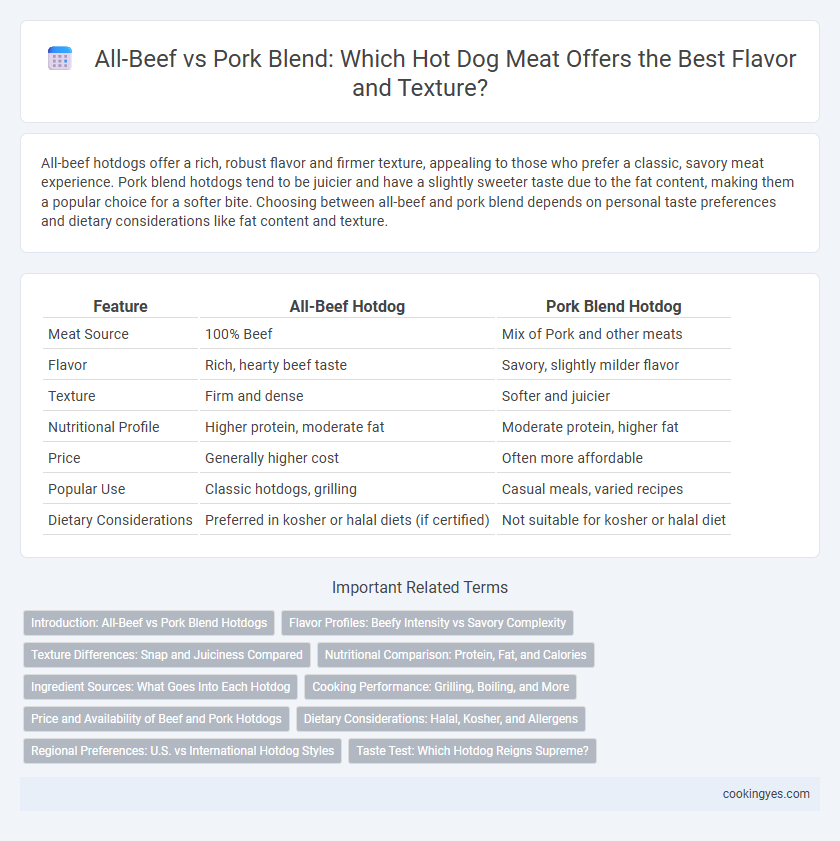All-beef hotdogs offer a rich, robust flavor and firmer texture, appealing to those who prefer a classic, savory meat experience. Pork blend hotdogs tend to be juicier and have a slightly sweeter taste due to the fat content, making them a popular choice for a softer bite. Choosing between all-beef and pork blend depends on personal taste preferences and dietary considerations like fat content and texture.
Table of Comparison
| Feature | All-Beef Hotdog | Pork Blend Hotdog |
|---|---|---|
| Meat Source | 100% Beef | Mix of Pork and other meats |
| Flavor | Rich, hearty beef taste | Savory, slightly milder flavor |
| Texture | Firm and dense | Softer and juicier |
| Nutritional Profile | Higher protein, moderate fat | Moderate protein, higher fat |
| Price | Generally higher cost | Often more affordable |
| Popular Use | Classic hotdogs, grilling | Casual meals, varied recipes |
| Dietary Considerations | Preferred in kosher or halal diets (if certified) | Not suitable for kosher or halal diet |
Introduction: All-Beef vs Pork Blend Hotdogs
All-beef hotdogs offer a distinct, rich flavor profile, appealing to consumers seeking a traditional and savory taste. Pork blend hotdogs combine pork with other meats, creating a juicier texture and a milder flavor, often favored for their affordability and versatility. Choosing between all-beef and pork blend hotdogs depends on dietary preferences, flavor intensity, and cultural considerations.
Flavor Profiles: Beefy Intensity vs Savory Complexity
All-beef hotdogs deliver a robust, beefy intensity with a rich, bold flavor that highlights the natural taste of high-quality beef cuts. Pork blend hotdogs offer a savory complexity, combining the slightly sweet and fatty notes of pork with complementary spices that create a well-rounded, juicy bite. Choosing between all-beef and pork blend hinges on preference for a pure, meaty punch versus a nuanced, layered flavor experience.
Texture Differences: Snap and Juiciness Compared
All-beef hotdogs feature a firmer texture with a distinctive snap due to the dense protein structure of beef, enhancing the eating experience. Pork blend hotdogs offer a softer bite and greater juiciness because of the higher fat content and marbling in pork, which melts during cooking. Texture preferences often depend on regional tastes, with beef hotdogs favored for their crisp snap and pork blends appreciated for their moist, tender mouthfeel.
Nutritional Comparison: Protein, Fat, and Calories
All-beef hotdogs contain higher protein content, averaging around 5-7 grams per serving, compared to pork blend hotdogs, which typically offer 4-6 grams. Fat content in pork blend hotdogs can be slightly higher, often ranging from 7-9 grams, whereas all-beef versions generally contain 6-8 grams of fat per serving. Calorie counts are similar but may vary slightly, with all-beef hotdogs providing approximately 150-180 calories and pork blends ranging from 160-190 calories per standard hotdog.
Ingredient Sources: What Goes Into Each Hotdog
All-beef hotdogs use premium cuts from cattle, ensuring a rich, savory flavor derived solely from beef muscle meat and natural seasonings. Pork blend hotdogs combine lean pork with beef or other meats, creating a mix that balances tenderness and mouthfeel with spices and fillers such as wheat or soy protein. Ingredient sourcing in all-beef options is often prioritized for quality and purity, while pork blends may incorporate a wider variety of additives to enhance texture and cost-efficiency.
Cooking Performance: Grilling, Boiling, and More
All-beef hotdogs maintain their shape and flavor better during grilling, providing a firmer texture and less grease flare-up, while pork blend hotdogs offer a juicier bite and softer casing that responds well to boiling and steaming. When boiling, pork blends tend to retain moisture more effectively, resulting in a tender bite, whereas all-beef varieties require precise timing to avoid drying out. For versatile cooking performance, consider the beef content's impact on cooking temperature tolerance and flavor concentration during grilling or pan-frying techniques.
Price and Availability of Beef and Pork Hotdogs
All-beef hotdogs typically command a higher price due to the increased cost of beef compared to pork, reflecting the premium quality associated with pure beef products. Pork blend hotdogs offer a more affordable option with wider availability, as pork is often easier to source and can be combined with other meats to reduce production costs. Availability of beef hotdogs tends to be concentrated in specialty or premium markets, whereas pork blend varieties dominate mainstream grocery stores for budget-conscious consumers.
Dietary Considerations: Halal, Kosher, and Allergens
All-beef hotdogs are preferred in halal and kosher diets due to strict religious dietary laws prohibiting pork, ensuring compliance with Islamic and Jewish food regulations. Pork blend hotdogs may pose concerns for those avoiding pork for religious reasons or due to allergies, as pork can trigger sensitivities in certain individuals. Consumers with dietary restrictions should carefully check ingredient labels and certification to select hotdogs that meet halal, kosher, and allergen-free requirements.
Regional Preferences: U.S. vs International Hotdog Styles
All-beef hotdogs dominate the U.S. market, especially in regions like New York and Chicago, where kosher and halal dietary laws influence consumer preferences. Internationally, pork blend hotdogs are more prevalent, benefiting from the pork-rich culinary traditions in Europe and Asia. Regional taste profiles and cultural influences strongly dictate the choice between all-beef and pork blend hotdog meats.
Taste Test: Which Hotdog Reigns Supreme?
All-beef hotdogs deliver a robust, smoky flavor with a firm texture that appeals to traditionalists seeking authentic, savory bites. Pork blend hotdogs offer a juicier, slightly sweeter taste with a softer bite, often favored in regional recipes for their rich, succulent profile. In taste tests, preference hinges on individual palate, though all-beef varieties generally dominate when bold, classic flavor is the priority.
All-Beef vs Pork Blend for Hotdog Meat Infographic

 cookingyes.com
cookingyes.com